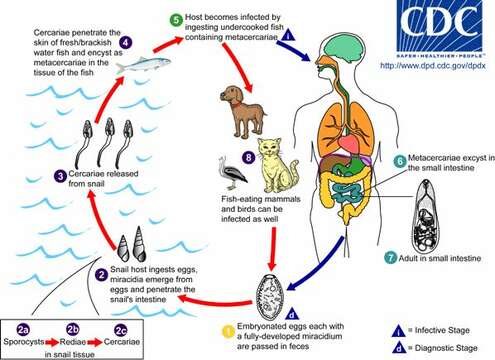Life cycle of the trematode Metagonimus yokogawai

Description :
Life cycle of the trematode Metagonimus yokogawai
Adult Metagonimus yokogawai release fully embryonated eggs, each with a fully-developed miracidium, and eggs are passed in the host’s feces (1). After ingestion by a suitable snail (first intermediate host), the eggs hatch and release miracidia, which penetrate the snail’s intestine (2). Snails of the genus Semisulcospira are the most frequent intermediate host for M. yokogawai. The miracidia pass through several developmental stages in the snail: sporocysts (2a), rediae (2b), and cercariae (2c). Many cercariae are produced from each redia. The cercariae are released from the snail (3) and encyst as metacercariae in the tissues of a suitable fresh/brackish water fish (second intermediate host) (4). The definitive host becomes infected by ingesting undercooked or salted fish containing metacercariae (5). After ingestion, the metacercariae excyst, attach to the mucosa of the small intestine (6), and mature into adults (which measure only 1.0 mm to 2.5 mm by 0.4 mm to 0.75 mm) (7). In addition to humans, fish-eating mammals (e.g., cats and dogs) and birds can also be infected by M. yokogawai (8).
From Centers for Disease Control Parasites and Health website
Inclus dans les pages suivantes :
- Life
- Cellular (Organismes cellulaires)
- Eukaryota (eucaryotes)
- Opisthokonta
- Metazoa (animaux)
- Bilateria
- Protostomia
- Spiralia
- Platyhelminthes (Plathelminthes)
- Trematoda
- Opisthorchioidea
- Heterophyidae
- Metagonimus
- Rhabditophora
- Metagonimus yokogawai
Cette image ne figure dans aucune collection.
Informations sur la provenance
- licence
- cc-by-nc
- droit d’auteur
- Centers for Disease Control/Division of Parasitic Diseases and Malaria
- éditeur de publication
- Shapiro, Leo
- photographe
- Centers for Disease Control/Division of Parasitic Diseases and Malaria
- fournisseur
- EOL Rapid Response Team
- original
- fichier de média d’origine
- visiter la source
- site partenaire
- EOL staff
- ID


